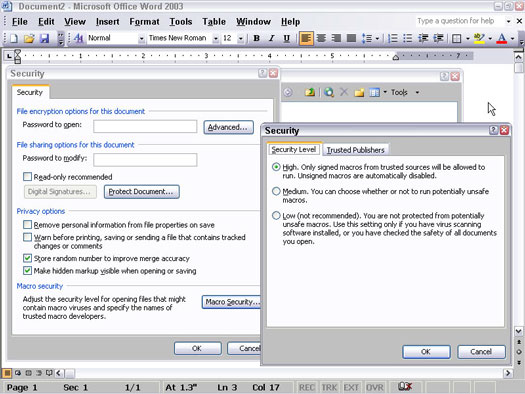Microsoft Office 2003 gives you two ways to create a macro. The simplest way is to record your keystrokes and then play them back when you need them. The harder way to create a macro is to use the Microsoft special macro programming language (called Visual Basic for Applications or VBA) to create more powerful and complicated macros.
Although the VBA programming language gives you the power to create a variety of different macros, it has also given mischievous programmers the opportunity to write computer viruses.
This new breed of computer viruses, dubbed macro viruses, can infect Word documents, Excel worksheets, PowerPoint presentations, and Access databases. When you give a copy of a document or worksheet that contains a virus to another person, you risk passing along the macro virus at the same time.
So to help prevent macro viruses from infecting and spreading through your Office 2003 files, Office 2003 offers a limited form of macro virus protection.
The most common macro viruses infect Word documents. The second most common macro viruses infect Excel worksheets; a handful of macro viruses attack PowerPoint or Access files. Buy an antivirus program and keep it updated regularly, to protect yourself from any future macro viruses that might attack your computer.
To turn on macro virus protection in Word, follow these steps:
1. Choose File --> Save or Save As.
A Save As dialog box appears.
2. Click in the Tools menu that appears in the upper-right corner of the Save As dialog box.
A drop-down menu appears.
3. Click Security Options.
A Security dialog box appears.
4. Click Macro Security.
Another Security dialog box appears, as shown in Figure 1.

Figure 1: The Security dialog box for changing the macro security setting for Word documents.
5. Click the Security Level tab and click the High, Medium, or Low radio button.
Unless you have a good reason for choosing a lower security level, you should always choose the High radio button.
If you choose the High Security Level, you may not be able to run macros created by someone else unless you set the security level to Medium or Low.
The High Security Level helps prevent macro viruses from infecting your files, but some macro viruses are clever enough to shut this feature off. Don't rely on Office 2003's macro virus protection to keep your computer virus-free.
6. Click OK twice.
The Save As dialog box appears again. Each time you save your document, Word uses your chosen security settings for this document.
7. Click Save.
If a macro virus has already infected your Word documents or Excel worksheets, turning on Office 2003's macro virus protection won't remove the virus. You should get an antivirus program, such as McAfee's VirusScan or Symantec's Norton AntiVirus, that can detect and remove macro and other types of viruses.
dummies
Source:http://www.dummies.com/how-to/content/watching-out-for-macro-viruses-in-office-2003.html
No comments:
Post a Comment